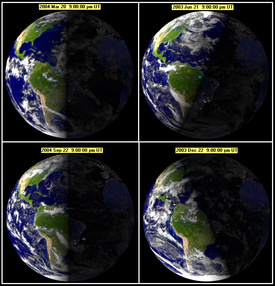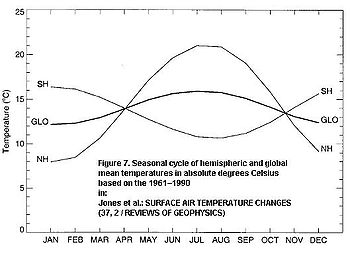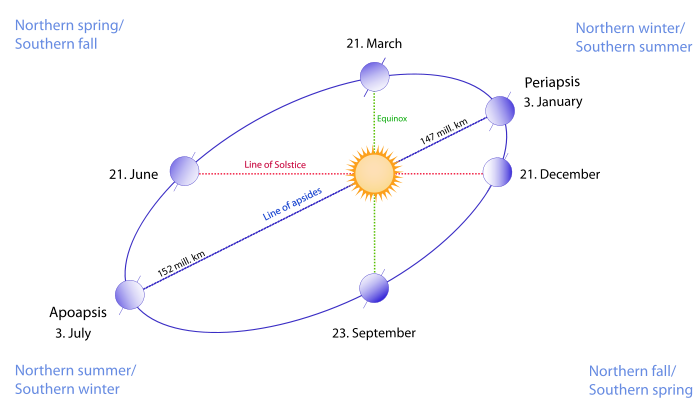
Season
About this schools Wikipedia selection
This Wikipedia selection is available offline from SOS Children for distribution in the developing world. A good way to help other children is by sponsoring a child
A season is a division of the year, marked by changes in weather, ecology, and hours of daylight.
Seasons result from the yearly revolution of the Earth around the Sun and the tilt of the Earth's axis relative to the plane of revolution. In temperate and polar regions, the seasons are marked by changes in the intensity of sunlight that reaches the Earth's surface, variations of which may cause animals to go into hibernation or to migrate, and plants to be dormant.
During May, June and July, the northern hemisphere is exposed to more direct sunlight because the hemisphere faces the sun. The same is true of the southern hemisphere in November, December and January. It is the tilt of the Earth that causes the Sun to be higher in the sky during the summer months which increases the solar flux. However, due to seasonal lag, June, July and August are the hottest months in the northern hemisphere and December, January and February are the hottest months in the southern hemisphere.
In temperate and subpolar regions, generally four calendar-based seasons (with their adjectives) are recognized: spring (vernal), summer (estival), autumn (autumnal) and winter (hibernal). However, ecologists are increasingly using a six-season model for temperate climate regions that includes pre-spring (prevernal) and late summer (seritonal) as distinct seasons along with the traditional four (See Ecological Seasons below).
In some tropical and subtropical regions it is more common to speak of the rainy (or wet, or monsoon) season versus the dry season, because the amount of precipitation may vary more dramatically than the average temperature. For example, in Nicaragua, the dry season (November to April) is called 'summer' and the rainy season (May to October) is called 'winter', even though it is located in the northern hemisphere.
In other tropical areas a three-way division into hot, rainy, and cool season is used.
In some parts of the world, special "seasons" are loosely defined based on important events such as a hurricane season, tornado season or a wildfire season.
Causes and effects
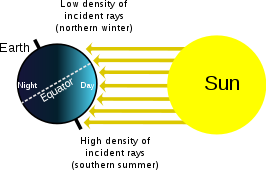
This is a diagram of the seasons. Regardless of the time of day (i.e. the Earth's rotation on its axis), the North Pole will be dark, and the South Pole will be illuminated; see also arctic winter. In addition to the density of incident light, the dissipation of light in the atmosphere is greater when it falls at a shallow angle.
The seasons result from the Earth's axis being tilted to its orbital plane; it deviates by an angle of approximately 23.5 degrees. Thus, at any given time during summer or winter, one part of the planet is more directly exposed to the rays of the Sun (see Fig. 1). This exposure alternates as the Earth revolves in its orbit. Therefore, at any given time, regardless of season, the northern and southern hemispheres experience opposite seasons.
The effect of axis tilt is observable from the change in day length, and altitude of the Sun at noon (the culmination of the Sun), during a year.
Seasonal weather differences between hemispheres are further caused by the elliptical orbit of Earth. Earth reaches perihelion (the point in its orbit closest to the Sun) in January, and it reaches aphelion (farthest point from the Sun) in July. Even though the effect this has on Earth's seasons is minor, it does noticeably soften the northern hemisphere's winters and summers. In the southern hemisphere, the opposite effect is observed.
Seasonal weather fluctuations (changes) also depend on factors such as proximity to oceans or other large bodies of water, currents in those oceans, El Niño/ENSO and other oceanic cycles, and prevailing winds.
In the temperate and polar regions, seasons are marked by changes in the amount of sunlight, which in turn often causes cycles of dormancy in plants and hibernation in animals. These effects vary with latitude and with proximity to bodies of water. For example, the South Pole is in the middle of the continent of Antarctica and therefore a considerable distance from the moderating influence of the southern oceans. The North Pole is in the Arctic Ocean, and thus its temperature extremes are buffered by the water. The result is that the South Pole is consistently colder during the southern winter than the North Pole during the northern winter.
The cycle of seasons in the polar and temperate zones of one hemisphere is opposite to that in the other. When it is summer in the Northern Hemisphere, it is winter in the Southern Hemisphere, and vice versa.
In the tropics, there is no noticeable change in the amount of sunlight. However, many regions (such as the northern Indian ocean) are subject to monsoon rain and wind cycles. A study of temperature records over the past 300 years shows that the climatic seasons, and thus the seasonal year, are governed by the anomalistic year rather than the tropical year.
In meteorological terms, the summer solstice and winter solstice (or the maximum and minimum insolation, respectively) do not fall in the middles of summer and winter. The heights of these seasons occur up to seven weeks later because of seasonal lag. Seasons, though, are not always defined in meteorological terms.
Compared to axial tilt, other factors contribute little to seasonal temperature changes. The seasons are not the result of the variation in Earth’s distance to the sun because of its elliptical orbit. Orbital eccentricity can influence temperatures, but on Earth, this effect is small and is more than counteracted by other factors; research shows that the Earth as a whole is actually slightly warmer when farther from the sun. This is because the northern hemisphere has more land than the southern, and land warms more readily than sea. Mars however experiences wide temperature variations and violent dust storms every year at perihelion.
Polar day and night
Any point north of the Arctic Circle or south of the Antarctic Circle will have one period in the summer when the sun does not set, and one period in the winter when the sun does not rise. At progressively higher latitudes, the maximum periods of " midnight sun" and " polar night" are progressively longer. For example, at the military and weather station Alert on the northern tip of Ellesmere Island, Canada (about 450 nautical miles or 830 km from the North Pole), the sun begins to peek above the horizon in mid-February and each day it climbs higher and stays up longer; by 21 March, the sun is up for 12 hours. However, mid-February is not first light. The sky (as seen from Alert) has twilight, or at least a pre-dawn glow on the horizon, for increasing hours each day, for more than a month before the sun first appears.
In the weeks surrounding 21 June, the sun is at its highest, and it appears to circle the sky without going below the horizon. Eventually, it does go below the horizon, for progressively longer periods each day until, around the middle of November, it disappears for the last time. For a few more weeks, "day" is marked by decreasing periods of twilight. Eventually, for the weeks surrounding 21 December, it is continuously dark. In later winter, the first faint wash of light briefly touches the horizon (for just minutes per day), and then increases in duration and pre-dawn brightness each day until sunrise in February.
Reckoning
Meteorological
Meteorological seasons are reckoned by temperature, with summer being the hottest quarter of the year and winter the coldest quarter of the year. Using this reckoning, the Roman calendar began the year and the spring season on the first of March, with each season occupying three months. In 1780 the Societas Meteorologica Palatina, an early international organization for meteorology, defined seasons as groupings of three whole months. Ever since, professional meteorologists all over the world have used this definition. Therefore, in meteorology for the Northern hemisphere, spring begins on 1 March, summer on 1 June, autumn on 1 September, and winter on 1 December.
In Sweden and Finland, meteorologists use a different definition for the seasons, based on the temperature: spring begins when the daily averaged temperature permanently rises above 0° C, summer begins when the temperature permanently rises above +10° C, summer ends when the temperature permanently falls below +10° C and winter begins when the temperature permanently falls below 0° C. "Permanently" here means that the daily averaged temperature has remained above or below the limit for seven consecutive days. This implies two things: first, the seasons do not begin at fixed dates but must be determined by observation and are known only after the fact; and second, a new season begins at different dates in different parts of the country.
| Surface air temperature | |
|---|---|
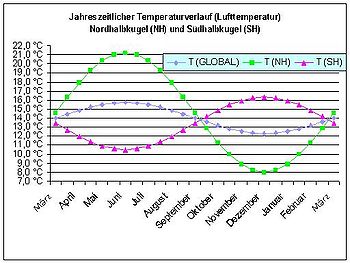
Diagram was calculated (Abscisse: 21. of each month)
Calculation based on data published by Jones et al. |
|
Astronomical
The following diagram shows the relation between the line of solstice and the line of apsides of Earth's elliptical orbit. The orbital ellipse (with eccentricity exaggerated for effect) goes through each of the six Earth images, which are sequentially the perihelion (periapsis—nearest point to the sun) on anywhere from 2 January to 5 January, the point of March equinox on 20 or 21 March, the point of June solstice on 20 or 21 June, the aphelion (apoapsis—farthest point from the sun) on anywhere from 4 July to 7 July, the September equinox on 22 or 23 September, and the December solstice on 21 or 22 December.
In astronomical reckoning, the solstices and equinoxes ought to be the middle of the respective seasons, but, because of thermal lag, regions with a continental climate often consider these four dates to be the start of the seasons as in the diagram, with the cross-quarter days considered seasonal midpoints. The length of these seasons is not uniform because of the elliptical orbit of the earth and its different speeds along that orbit.
From the March equinox it takes 92.75 days until the June solstice, then 93.65 days until the September equinox, 89.85 days until the December solstice and finally 88.99 days until the March equinox. In Canada and the United States, the mass media consider the astronomical seasons " official" over all other reckonings, but no legal basis exists for this designation.
Because of the differences in the Northern and Southern Hemispheres, it is no longer considered appropriate to use the northern-seasonal designations for the astronomical quarter days. The modern convention for them is: March Equinox, June Solstice, September Equinox and December Solstice. The oceanic climate of the Southern Hemisphere produces a shorter temperature lag, so the start of each season is usually considered to be several weeks before the respective solstice or equinox in this hemisphere, in other countries with oceanic climates, and in cultures with Celtic roots.
Ecological seasons

Ecologically speaking, a season is a period of the year in which only certain types of floral and animal events happen (e.g.: flowers bloom—spring; hedgehogs hibernate—winter). So, if we can observe a change in daily floral/animal events, the season is changing.
Hot regions
Hot regions have two seasons:
- Rainy season
- Dry season
Temperate areas
Six seasons can be distinguished. Mild temperate regions tend to experience the beginning of the hibernal season up to a month later than cool temperate areas, while the prevernal and vernal seasons begin up to a month earlier. For example, prevernal crocus blooms typically appear as early as February in mild coastal areas of British Columbia, the British Isles, and western and southern Europe. The actual dates for each season vary by climate region and can shift from one year to the next. Average dates listed here are for cool temperate climate zones in the Northern Hemisphere:
- Prevernal (ca.1 March–1 May)
- Vernal (ca.1 May–15 June)
- Estival (ca.15 June–15 August)
- Serotinal (ca.15 August–15 September)
- Autumnal (ca.15 September–1 November)
- Hibernal (ca.1 November–1 March)
Cold regions
There are again only two seasons:
- Polar Day (spring and summer)
- Polar Night (autumn and winter)
Traditional season divisions
| Traditional temperate seasonal changes on a city road in Manchester, UK: | ||||
 |
 |
 |
 |
|
| Spring | Summer | Autumn | Winter | |
Traditional seasons are reckoned by insolation, with summer being the quarter of the year with the greatest insolation and winter the quarter with the least. These seasons begin about four weeks earlier than the meteorological seasons and 7 weeks earlier than the astronomical seasons.
In traditional reckoning, the seasons begin at the cross-quarter days. The solstices and equinoxes are the midpoints of these seasons. For example, the days of greatest and least insolation are considered the "midsummer" and "midwinter" respectively.
This reckoning is used by various traditional cultures in the Northern Hemisphere, including East Asian and Irish cultures. In Iran, Afghanistan and some other parts of Middle East the beginning of the astronomical spring is the beginning of the new year which is called Nowruz.
So, according to traditional reckoning, winter begins between 5 November and 10 November, Samhain, 立冬 (lìdōng or rittou); spring between 2 February and 7 February, Imbolc, 立春 (lìchūn or risshun); summer between 4 May and 10 May, Beltane, 立夏 (lìxià or rikka); and autumn between 3 August and 10 August, Lughnasadh, 立秋 (lìqiū or risshū). The middle of each season is considered Mid-winter, between 20 December and 23 December, 冬至 (dōngzhì or touji); Mid-spring, between 19 March and 22 March, 春分 (chūnfēn or shunbun); Mid-summer, between 19 June and 23 June, 夏至 (xiàzhì or geshi); and Mid-autumn, between 21 September and 24 September, 秋分 (qiūfēn or shūbun).
Australia
The traditional aboriginal people of Australia defined the seasons by what was happening to the plants, animals and weather around them. This led to each separate tribal group having different seasons, some with up to eight seasons each year. However, most modern Aboriginal Australians follow either four or six meteorological seasons, as do non-Aboriginal Australians.
The commonly followed dates are as follows: 1st day of March, June, September and December for the start of Autumn, Winter, Spring and Summer, respectively.
Celts
The ancient Celts recognised only two seasons: summer and winter. These were marked by festivals, Samhain and Beltaine, to celebrate the death and rebirth of the sun.
China
Chinese seasons are traditionally based on 24 periods known as solar terms, and begin at the midpoint of solstices and equinoxes.
India
In India, and in the Hindu calendar, there are six seasons or Ritu: Vasanta (Spring), Greeshma (Summer), Varsha ( Monsoon) and Sharad (Autumn), Hemanta (pre-hibernal), Shishira (Winter).
The six seasons are ascribed to two months each of the twelve months in the Hindu calendar. The rough correspondences are:
| Hindu season | Start | End | Hindu Months |
|---|---|---|---|
| Greeshma | mid-April | mid-June | Vaishakha, Jyestha |
| Varsha | mid-June | mid-August | Ashadha, Shravana |
| Sharad | mid-August | mid-October | Bhadrapada, Ashwayuja |
| Hemanta | mid-October | mid-December | Kartika, Maargashira |
| Shishira | mid-December | mid-February | Pushya, Magha |
| Vasanta | mid-February | mid-April | Phalguna, Chaitra |

